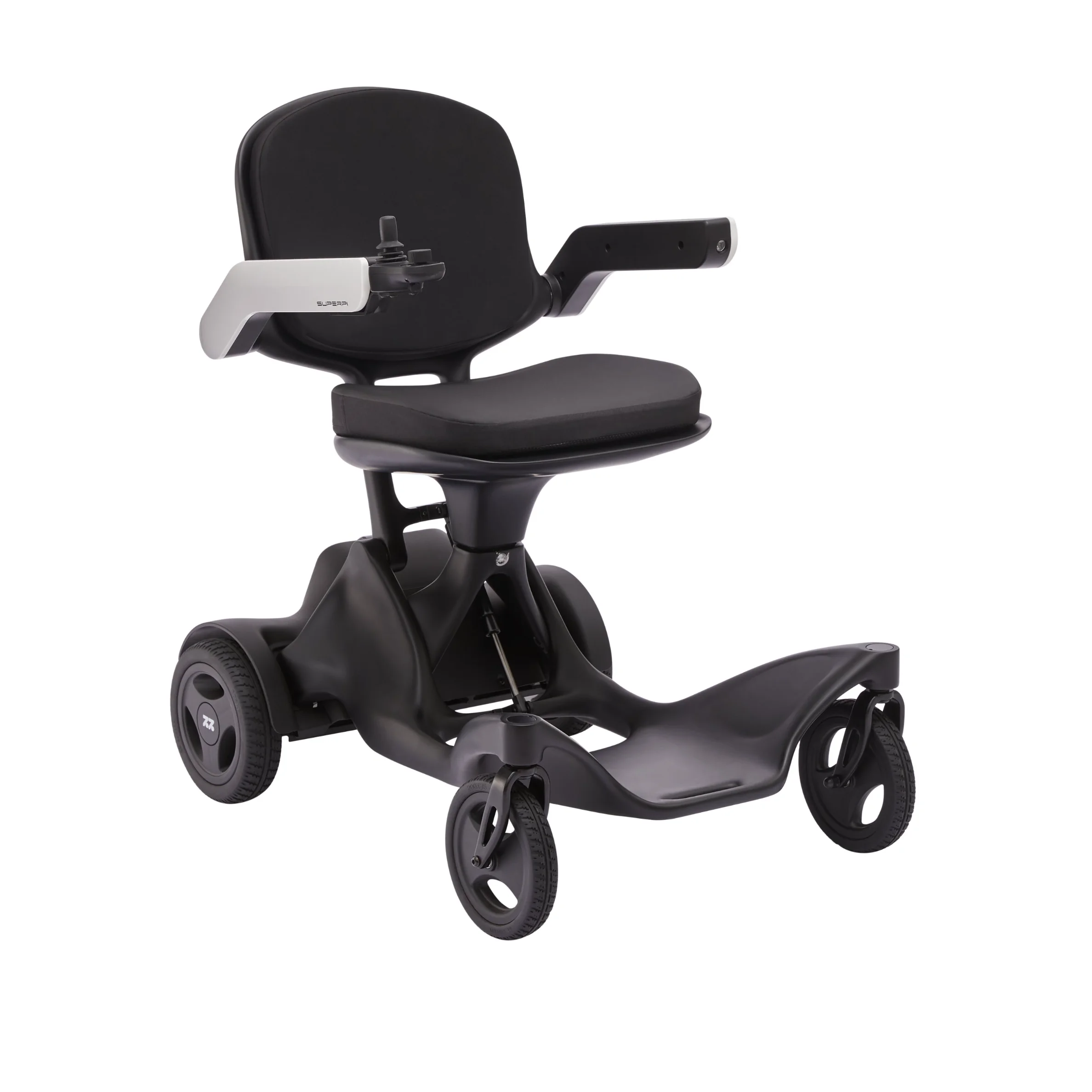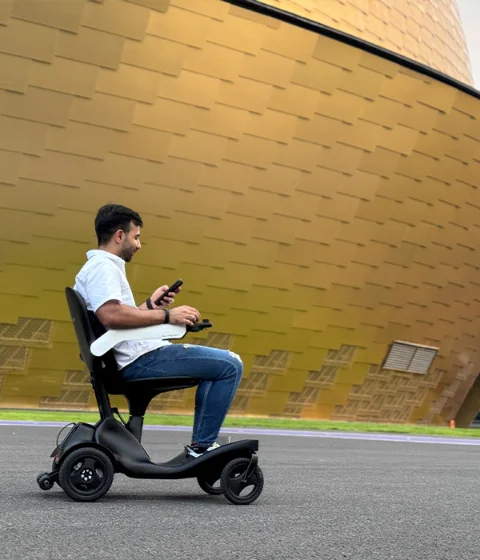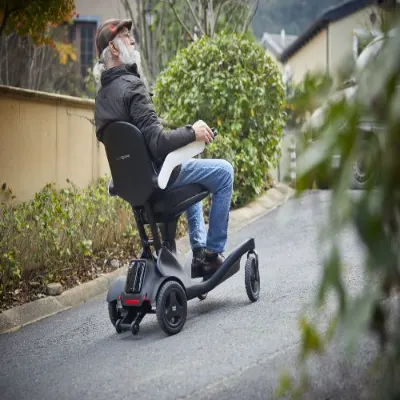
When evaluating electric wheelchairs, battery life is a crucial factor influencing daily mobility and independence. The Super Pi Robot P2 offers two battery options—10Ah and 20Ah—catering to varying user needs. This comparison looks at how a carbon build versus aluminum affects daily carry, comfort, range, and what actually helps on flights and tight city routes.
What Matters Most for Daily Travel?
Daily travel is elevators, curb cuts, station ramps, and quick trunk loads. So the priorities are simple: total carry weight, folded size, hallway turning, true range on mixed surfaces, and how fast you fold, stow, and go again. If a feature doesn’t save effort in those moments, it fades after week one.
Stated Frame Weight vs. True Carry Weight
Spec weight is a start. Real carry weight is what you feel when you remove the pack and lift the frame. Carbon often shaves grams with good stiffness, which helps during car-trunk transfers. Aluminum can be close if the battery sits low and the grab point is centered.
Fold Mechanisms, Handles, and Balance Points
Quick-fold locks and a center-of-mass handle cut motions per transfer. That’s the quiet reason some chairs feel “lighter” than the scale says.
Turning Radius and Tight Corridors
A compact footprint that pivots without shunting saves your shoulders and keeps hallway corners clean. Less correction means less fatigue.
How Do Frame Materials Change Real-World Portability?
Portability is the full loop: fold, lift, stow, unfold, ride. Carbon’s stiffness-to-weight is the headline; aluminum’s draw is familiar service and friendlier entry price. Both can travel well; the winner trims seconds from the routine with no drama.
Carbon Fiber Electric Wheelchair: Where It Wins
A carbon backrest and seat pan reduce mass and feel solid over broken tiles. Paired with supportive foam, vibration spikes into the spine are lower on choppy ground.
Aluminum Frames: What Still Works
Aluminum remains a strong option for budget control and easy service. If the geometry and fold are right, it still handles tight spaces and daily lifts without fuss.
Balance, Not Just Mass
Weight distribution decides how a chair “comes off the ground.” A slightly heavier but well-balanced frame can lift easier than a lighter but nose-heavy one.
Which Material Handles Vibration, Comfort, and Fatigue Better?
Your day mixes tile, asphalt patches, and ramp plates. Comfort is the seat, suspension, tire compliance, and how the frame transmits vibration.
Damping, Flex, and Seat Interfaces
Carbon structures plus a quality cushion reduce peak jolts. Foam density and contour matter more than spec sheets suggest.
Suspension Details That Matter
Independent rear suspension and rubber damping soften expansion joints and curb lips. Fewer “micro-brakes” during a mile of sidewalks equals a calmer ride.
Long Rides on Uneven Surfaces
At 4–6 km/h, frequency bothers you more than amplitude. Stable frames with correct tire pressure often beat heavier builds with poor damping.
What About Strength, Load Rating, and Durability?
You want tight hardware after a year of folds and curbs. Check load rating, corrosion behavior, and known fatigue points.
Stiffness-to-Weight, Torsion, and Hardware
Stiff frames track straighter in crowds. Hinge pins, latch bushings, and arm mounts decide how quiet the ride stays.
Corrosion and Weather
IPX-type splash protection helps in light rain, but quick wipe-downs do most of the work. Salt and wet sidewalks age cosmetics; covers prevent 80% of scuffs.
Fatigue and Impacts
Gas-spring-assisted locks lower the “wrestle factor,” so mechanisms stay tight longer. Sloppy folds are what loosen parts.
How Do Motors, Batteries, and Electronics Pair With Each Frame?
Range is amp-hours, yes, but also terrain, slope, rider weight, and controller tuning. Removable packs make life easier in daily use and on flights.
Range and Hills: Reading the Numbers
Two pack sizes—10Ah and 20Ah—map to two range bands. If your loop includes repeated short ramps, the larger pack adds buffer for cold days and headwinds.
Controller, Cable Routing, and Protection
Brushless motors and tidy routing give steadier torque and fewer snags in crowds. Protected connectors reduce intermittent faults after thousands of folds.
Battery Swaps, Docs, and Flights
Removable lithium packs simplify compliance. For an airline approved power wheelchair, confirm watt-hours and bring printed docs. Clean detach points matter at check-in. If you compare options, review power wheelchair battery choices on the Products page and match capacity to your longest day with a buffer.

Is Repair and Maintenance Easier on Carbon Fiber or Aluminum?
Travel adds small knocks. Planning for quick service keeps you rolling.
Field Fixes and Turnaround Time
Aluminum bends and scratches are familiar to service techs and parts are common. Carbon damage is rare day to day but needs a proper shop if it occurs.
Cosmetics Over Time
Carbon tends to hide minor scuffs; aluminum shows nicks. A soft sleeve during trunk travel prevents most marks on either material.
What’s Realistic After Year One
Budget for tires, armrest pads, and a hinge check. Sealed connectors and a tucked-in controller case keep electronics quiet.
What’s the Cost Curve and Total Value Over 2–3 Years?
Value is time and effort you don’t spend. Fewer lifts, faster folds, and fewer “almost missed the bus” moments add up fast.
Purchase Price vs. Caregiver Effort
If a partner lifts often, 1–2 kg less in hand matters week after week. That’s the math missing from many spec sheets.
Resale, Warranty, and Support
Quiet, tight frames hold value better. A simple log of battery health and hinge checks helps at resale.
When a Lighter Frame Pays for Itself
Daily trunk lifts and two transit transfers give the lighter build a clear edge. If you mostly roll short indoor routes with roomy elevators, aluminum may deliver the same outcome for less.
Are Airline and Transit Rules Easier With One Material?
Airlines care about batteries and folded size; material comes second. Transit cares about turning, ramp thresholds, and holding still on slopes.
Folded Size, Documents, and Gate Check
Know your folded dimensions and bring battery paperwork. A rigid fold with a strap speeds gate-side handling for power wheelchair for travel flights.
Ramps, Lift Plates, and Crowd Flow
A small turning radius and controlled starts keep station entries calm. “Stop when you release” behavior helps on busy ramps.
Packing Tips for Flights
Wrap armrests, strap the folded frame, and tape a card with contact details to the side. Simple steps prevent 90% of scuffs.
Who Should Choose Carbon Fiber, and Who Should Pick Aluminum?
Pick the frame for the day you actually live.
Carbon Fiber: Frequent Flyers and Solo Lifts
If you fly often, use rideshares, and lift alone, carbon saves effort every fold and trunk move.
Aluminum: Budget-Friendly and Mixed Terrain
If trips are shorter and elevators are generous, aluminum hits the value target with straightforward service.
Caregiver-Led Routines
For caregiver-assisted transfers, quick fold, clear handles, and low lift height matter more than the last 300 grams.
Side-By-Side Scorecard: Carbon Fiber vs. Aluminum?
Weight/portability: carbon 5, aluminum 4. Comfort/vibration: carbon 5 with good foam, aluminum 4 with tuned suspension. Durability: tie at 4 if serviced. Maintenance: aluminum 5 for familiarity. Travel readiness: tie at 4–5 depending on fold and battery docs.
Buying Checklist Before You Decide?
- Test a lift into your actual trunk
- Measure folded size against elevator and hall widths
- Try a hallway pivot to feel turning effort
- Map your daily loop and size the pack with 20% buffer
- Ask about parts lead time and local service
حول Super Pi Robot
روبوت سوبر بي focuses on lightweight, travel-ready power chairs that fold fast, ride stable, and fit small spaces. The P2 platform pairs a supportive seat system with brushless dual-motor drive, removable lithium packs in 10Ah or 20Ah, independent rear suspension, and practical splash protection for real sidewalks. You get calm starts on ramps, tidy pivots in narrow halls, and a folded package that fits common trunks. If daily life means elevators, transfers, or flights, this is a clean starting point for low-stress travel.
FAQ
Q1: How do you choose between 10Ah and 20Ah packs?
A: Match capacity to your longest day with a 20% buffer. Short urban loops suit the smaller pack; longer errands and slope repeats favor the larger.
Q2: Does carbon fiber always mean lighter to carry?
A: Usually, but balance and grab points decide how it lifts. A well-balanced aluminum frame can feel easier than a lighter nose-heavy build.
Q3: What matters most for an airline approved power wheelchair?
A: Removable batteries with clear watt-hour specs, folded size that fits guidance, and printed documentation at check-in.
Q4: Is a power wheelchair for travel flights different from a daily chair?
A: The best travel chairs are daily chairs that fold fast, ride steady, and document batteries well. One solid pick can cover both jobs.
Q5: How do you stay comfortable on rough surfaces?
A: Pair a supportive cushion with rear suspension and correct tire pressure. You’ll feel fewer jolts on tiles and curb lips over long days.






